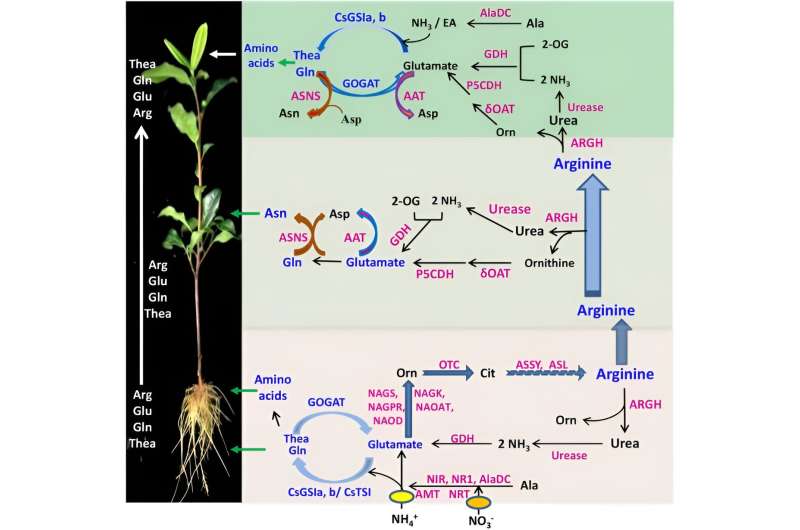This article has been reviewed according to Science X's editorial process and policies. Editors have highlighted the following attributes while ensuring the content's credibility:
fact-checked
peer-reviewed publication
proofread
Unlocking the tea leaf's secret: Decoding the amino acid blueprint of tea plant

Amino acids are vital for plant growth and significantly influence tea flavor and health benefits. Tea plants, particularly Camellia sinensis, exhibit unique amino acid profiles that contribute to their distinctive taste and nutritional value.
Despite the known importance of amino acids like theanine and glutamine (Gln), the detailed dynamics of their synthesis, transport, and degradation in tea plants remain unclear. Due to these challenges, there is a need to conduct in-depth research to understand the complex metabolic pathways and spatial distribution of amino acids within tea plants.
Researchers from Hunan Agricultural University, in a study published in Horticulture Research, dissected the spatial dynamics of amino acid biosynthesis, transport, and turnover in tea plants.
The study provides a detailed analysis of the metabolic pathways and gene expressions that govern these processes. By understanding these mechanisms, the researchers aim to improve tea cultivation and enhance the quality of tea beverages.
The study revealed that nitrogen assimilation primarily occurs in the roots, where Gln, theanine, and arginine (Arg) are actively synthesized. These amino acids are then transported through the plant's vascular system.
Transcriptome analyses identified that genes involved in Arg synthesis are highly expressed in roots, while genes responsible for Arg transport and degradation are expressed in stems and young leaves. This indicates a sophisticated system of amino acid management within the plant.
One key finding is the role of the CsGSIa gene, which is crucial for amino acid synthesis, transport, and recycling. Overexpression and knockdown experiments of CsGSIa in transgenic tea plants demonstrated its significant impact on Gln and theanine levels.
The study also highlighted that Arg, Gln, glutamate (Glu), and theanine are the major amino acids transported through the xylem sap, facilitating long-distance nitrogen transport from roots to leaves.
Dr. Jian Zhao, the senior researcher, stated, "Our findings offer a detailed map of amino acid metabolism in tea plants, which is crucial for both basic science and applied agricultural practices. Understanding these metabolic pathways opens up new possibilities for breeding tea varieties with enhanced flavors and health benefits."
The study's findings have significant implications for the tea industry. By elucidating the pathways of amino acid metabolism, this research paves the way for developing tea plants with higher levels of beneficial amino acids, enhancing both flavor and nutritional value.
These insights can be applied in breeding programs and cultivation practices to produce superior tea varieties. Additionally, understanding these metabolic processes can help in developing strategies to improve nitrogen utilization efficiency, contributing to more sustainable and productive tea farming.
More information: Shuwei Yu et al, Dissection of the spatial dynamics of biosynthesis, transport, and turnover of major amino acids in tea plants (Camellia sinensis), Horticulture Research (2024). DOI: 10.1093/hr/uhae060
Journal information: Horticulture Research
Provided by TranSpread



















